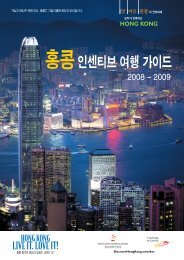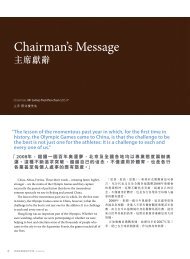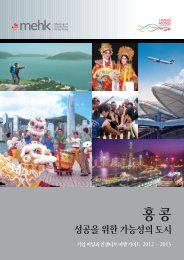æ ¸æ¸å¸«å ±åæ¸ - Discover Hong Kong
æ ¸æ¸å¸«å ±åæ¸ - Discover Hong Kong
æ ¸æ¸å¸«å ±åæ¸ - Discover Hong Kong
Create successful ePaper yourself
Turn your PDF publications into a flip-book with our unique Google optimized e-Paper software.
Auditors’ Report |
Auditors’ Report | <br />
Auditors’ report to the <strong>Hong</strong> <strong>Kong</strong> Tourism Board<br />
(“the Board”)<br />
(Established under the <strong>Hong</strong> <strong>Kong</strong> Tourist Association Ordinance and<br />
reconstituted under the <strong>Hong</strong> <strong>Kong</strong> Tourist Association (Amendment)<br />
Ordinance 2001 and the <strong>Hong</strong> <strong>Kong</strong> Tourism Board Ordinance)<br />
We have audited the financial statements on pages 121 to 141 which<br />
have been prepared in accordance with accounting principles generally<br />
accepted in <strong>Hong</strong> <strong>Kong</strong>.<br />
Respective responsibilities of the members of the Board and<br />
auditors<br />
The members of the Board are responsible for the preparation of financial<br />
statements which give a true and fair view. In preparing financial<br />
statements which give a true and fair view, it is fundamental that<br />
appropriate accounting policies are selected and applied consistently,<br />
that judgements and estimates are made which are prudent and<br />
reasonable and that the reasons for any significant departure from<br />
applicable accounting standards are stated.<br />
It is our responsibility to form an independent opinion, based on our audit,<br />
on those financial statements and to report our opinion solely to you, as<br />
a body, and for no other purpose. We do not assume responsibility<br />
towards or accept liability to any other person for the contents of this<br />
report.<br />
Basis of opinion<br />
We conducted our audit in accordance with <strong>Hong</strong> <strong>Kong</strong> Standards on<br />
Auditing issued by the <strong>Hong</strong> <strong>Kong</strong> Institute of Certified Public Accountants.<br />
An audit includes examination, on a test basis, of evidence relevant to<br />
the amounts and disclosures in the financial statements. It also includes<br />
an assessment of the significant estimates and judgements made by the<br />
members of the Board in the preparation of the financial statements, and<br />
of whether the accounting policies are appropriate to the Board’s<br />
circumstances, consistently applied and adequately disclosed.<br />
We planned and performed our audit so as to obtain all the information<br />
and explanations which we considered necessary in order to provide us<br />
with sufficient evidence to give reasonable assurance as to whether the<br />
financial statements are free from material misstatement. In forming our<br />
opinion, we also evaluated the overall adequacy of the presentation of<br />
information in the financial statements. We believe that our audit provides<br />
a reasonable basis for our opinion.<br />
Opinion<br />
In our opinion, the financial statements give a true and fair view of the<br />
state of the Board’s affairs as at 31 March 2006 and of its surplus and<br />
cash flows for the year then ended.<br />
<br />
<br />
<br />
2001<br />
<br />
121<br />
141<br />
<br />
<br />
<br />
<br />
<br />
<br />
<br />
<br />
<br />
<br />
<br />
<br />
<br />
<br />
<br />
<br />
<br />
<br />
<br />
<br />
<br />
<br />
<br />
<br />
<br />
2006331<br />
<br />
<br />
<br />
2006920<br />
KPMG<br />
Certified Public Accountants<br />
<strong>Hong</strong> <strong>Kong</strong>, 20 September 2006<br />
120
Income Statement | <br />
for the year ended 31 March 2006 (Expressed in <strong>Hong</strong> <strong>Kong</strong> dollars) 2006 3 31 <br />
Note<br />
2006 2005<br />
General Fund<br />
<br />
Principal source of income<br />
<br />
Government subvention 3 682,779,924 632,517,755<br />
Other revenue<br />
<br />
Interest income 8,054,630 2,718,770<br />
Realisation of deferred income<br />
<br />
– office premises 11 10,000,000 10,000,000<br />
Sponsorships 7,659,200 9,345,546<br />
Promotion and advertising income 6,890,031 6,218,604<br />
Sundry income 9,639,953 8,871,307<br />
42,243,814 37,154,227<br />
Other net income<br />
<br />
Gain on disposal of fixed assets 242,268 151,296<br />
Total income 725,266,006 669,823,278<br />
Promotional, advertising and<br />
<br />
literature expenses 366,921,598 354,033,507<br />
Research and development 35,864,282 28,924,891<br />
Local services and events 125,015,332 119,333,304<br />
Staff costs 5 149,453,261 149,320,409<br />
Rent, rates and management fees 12,217,191 12,343,722<br />
Depreciation 7 13,158,725 15,522,550<br />
Auditors’ remuneration 341,180 312,530<br />
Other operating expenses 21,364,466 22,346,993<br />
Total expenditure 724,336,035 702,137,906<br />
Net surplus/(deficit) from general fund 929,971 (32,314,628)<br />
Tourism Development Fund<br />
<br />
Realisation of deferred income 11 – 2,380,694<br />
Operating expenditure – 1,982,954<br />
Net surplus from Tourism<br />
<br />
Development Fund – 397,740<br />
Total net surplus/(deficit) for the year 3 929,971 (31,916,888)<br />
The notes on pages 125 to 141 form part of these financial statements.<br />
125141<br />
121
Balance sheet | <br />
at 31 March 2006 (Expressed in <strong>Hong</strong> <strong>Kong</strong> dollars) 2006 3 31 <br />
Note<br />
2006 2005<br />
Non-current assets<br />
<br />
Fixed assets 7 133,933,661 143,895,788<br />
Defined benefit plan asset 12(a) 24,509,000 25,009,000<br />
158,442,661 168,904,788<br />
Current assets<br />
<br />
Debtors, deposits and payments in advance 8 19,746,265 20,666,844<br />
Deposits with banks and financial institutions 9 251,021,909 246,189,813<br />
Cash at banks and in hand 9 20,629,629 18,370,922<br />
291,397,803 285,227,579<br />
Current liabilities<br />
<br />
Receipts in advance 14,081,343 14,161,203<br />
Accounts payable and accruals 10 139,944,375 135,792,598<br />
Bank overdrafts 1,239,453 533,244<br />
155,265,171 150,487,045<br />
Net current assets 136,132,632 134,740,534<br />
Non-current liabilities<br />
<br />
Deferred income 11 131,666,667 141,666,667<br />
Total non-current liabilities 131,666,667 141,666,667<br />
NET ASSETS 162,908,626 161,978,655<br />
Represented by:<br />
<br />
RESERVE<br />
<br />
General Fund 162,908,626 161,978,655<br />
Approved and authorised for issue on 20 September 2006<br />
2006920<br />
<br />
Clara Chong<br />
Executive Director<br />
<br />
<br />
The Hon Mrs Selina Chow GBS, OBE, JP<br />
Chairman of the Board<br />
<br />
<br />
The notes on pages 125 to 141 form part of these financial statements.<br />
125141<br />
122
Statement of Changes in Reserve | <br />
for the year ended 31 March 2006 (Expressed in <strong>Hong</strong> <strong>Kong</strong> dollars) 2006 3 31 <br />
2006 2005<br />
Accumulated surplus at the<br />
<br />
beginning of the year 161,978,655 193,895,543<br />
Surplus/(deficit) for the year 929,971 (31,916,888)<br />
Accumulated surplus at the end<br />
<br />
of the year 162,908,626 161,978,655<br />
The notes on pages 125 to 141 form part of these financial statements.<br />
125141<br />
123
Cash Flow Statement | <br />
for the year ended 31 March 2006 (Expressed in <strong>Hong</strong> <strong>Kong</strong> dollars) 2006 3 31 <br />
Note<br />
2006 2005<br />
Operating activities<br />
<br />
Surplus/(deficit) for the year 929,971 (31,916,888)<br />
Adjustments for:<br />
<br />
– Interest income (8,054,630) (2,718,770)<br />
– Depreciation 13,158,725 15,522,550<br />
– Gain on sale of fixed assets (242,268) (151,296)<br />
Operating surplus/(deficit) before <br />
changes in working capital 5,791,798 (19,264,404)<br />
Decrease/(increase) in defined benefit <br />
plan asset 500,000 (846,000)<br />
Decrease in debtors, deposits and<br />
<br />
payments in advance 1,301,929 3,269,241<br />
Increase/(decrease) in receipts in advance, <br />
accounts payable and accruals 4,071,917 (41,053,641)<br />
Decrease in deferred income (10,000,000) (12,380,694)<br />
Net cash generated from/(used in) <br />
operating activities 1,665,644 (70,275,498)<br />
Investing activities<br />
<br />
Interest received 7,673,280 2,575,061<br />
Purchase of fixed assets (3,196,598) (4,991,248)<br />
Proceeds from sale of fixed assets 242,268 151,296<br />
Net cash generated from/(used in) <br />
investing activities 4,718,950 (2,264,891)<br />
Net increase/(decrease) in cash and <br />
cash equivalents 6,384,594 (72,540,389)<br />
Cash and cash equivalents at<br />
<br />
beginning of year 9 264,027,491 336,567,880<br />
Cash and cash equivalents at<br />
<br />
end of year 9 270,412,085 264,027,491<br />
The notes on pages 125 to 141 form part of these financial statements.<br />
125141<br />
124
Notes on the Financial Statements | <br />
(Expressed in <strong>Hong</strong> <strong>Kong</strong> dollars)<br />
1 Status of the Board<br />
The <strong>Hong</strong> <strong>Kong</strong> Tourism Board (the “Board”) is a subvented body<br />
corporate established in 1957 under the <strong>Hong</strong> <strong>Kong</strong> Tourist<br />
Association Ordinance and reconstituted under the <strong>Hong</strong> <strong>Kong</strong><br />
Tourist Association (Amendment) Ordinance 2001 and the <strong>Hong</strong><br />
<strong>Kong</strong> Tourism Board Ordinance. Its registered office and principal<br />
place of operation is 11th Floor, Citicorp Centre, 18 Whitfield Road,<br />
North Point, <strong>Hong</strong> <strong>Kong</strong>.<br />
1 <br />
<br />
1957<br />
2001<br />
<br />
<br />
18<br />
11<br />
The principal activities of the Board are to market and promote <strong>Hong</strong><br />
<strong>Kong</strong> as a world-class tourist destination.<br />
<br />
<br />
2 Significant accounting policies<br />
(a) Statement of compliance<br />
These financial statements have been prepared in accordance<br />
with applicable <strong>Hong</strong> <strong>Kong</strong> Financial Reporting Standards<br />
(“HKFRSs”), which collective term includes the applicable<br />
individual <strong>Hong</strong> <strong>Kong</strong> Financial Reporting Standards, <strong>Hong</strong><br />
<strong>Kong</strong> Accounting Standards (“HKASs”) and Interpretations<br />
issued by the <strong>Hong</strong> <strong>Kong</strong> Institute of Certified Public<br />
Accountants (“HKICPA”), and accounting principles generally<br />
accepted in <strong>Hong</strong> <strong>Kong</strong>. A summary of the significant<br />
accounting policies adopted by the Board is set out below.<br />
The HKICPA has issued a number of new and revised HKFRSs<br />
that are effective or available for early adoption for accounting<br />
periods beginning on or after 1 January 2005. The adoption of<br />
these new and revised HKFRSs did not result in significant<br />
changes to the Board’s accounting policies applied in these<br />
financial statements for the years presented.<br />
2 <br />
(a) <br />
<br />
<br />
<br />
<br />
<br />
<br />
<br />
200511<br />
<br />
<br />
<br />
<br />
<br />
15<br />
The Board has not applied any new standard or interpretation<br />
that is not yet effective for the current accounting period (see<br />
note 15).<br />
125
Notes on the Financial Statements | <br />
(Expressed in <strong>Hong</strong> <strong>Kong</strong> dollars)<br />
2 Significant accounting policies (continued)<br />
(b) Basis of preparation of the financial statements<br />
The measurement basis used in the preparation of the financial<br />
statements is the historical cost basis.<br />
2 <br />
(b) <br />
<br />
<br />
The preparation of financial statements in conformity with<br />
HKFRSs requires management to make judgements, estimates<br />
and assumptions that affect the application of policies and<br />
reported amounts of assets, liabilities, income and expenses.<br />
The estimates and associated assumptions are based on<br />
historical experience and various other factors that are believed<br />
to be reasonable under the circumstances, the results of which<br />
form the basis of making the judgements about carrying values<br />
of assets and liabilities that are not readily apparent from other<br />
sources. Actual results may differ from these estimates.<br />
<br />
<br />
<br />
<br />
<br />
<br />
<br />
<br />
<br />
<br />
The estimates and underlying assumptions are reviewed on<br />
<br />
an ongoing basis. Revisions to accounting estimates are<br />
<br />
recognised in the period in which the estimates are revised if<br />
<br />
the revision affects only that period, or in the period of the<br />
<br />
revision and future periods if the revision affects both current<br />
<br />
and future periods.<br />
(c)<br />
<br />
(c)<br />
Films, publicity and advertising materials<br />
<br />
Films, publicity and advertising materials are charged to the<br />
<br />
income statement on purchase, and no account is taken of<br />
<br />
stocks on hand at the balance sheet date.<br />
(d)<br />
<br />
(d)<br />
Fixed assets<br />
(i)<br />
<br />
(i)<br />
Fixed assets are stated in the balance sheet at cost less<br />
<br />
accumulated depreciation and impairment losses.<br />
(ii)<br />
<br />
(ii)<br />
Gains or losses arising from the retirement or disposal of<br />
<br />
an item of fixed assets are determined as the difference<br />
<br />
between the estimated net disposal proceeds and the<br />
<br />
carrying amount of the item, and are recognised in the<br />
income statement on the date of retirement or disposal.<br />
126
Notes on the Financial Statements | <br />
(Expressed in <strong>Hong</strong> <strong>Kong</strong> dollars)<br />
2 Significant accounting policies (continued)<br />
(e) Depreciation<br />
Depreciation is calculated to write off the cost of fixed assets<br />
on a straight-line basis over their estimated useful lives as<br />
follows:<br />
2 <br />
(e) <br />
<br />
<br />
Leasehold properties<br />
25 years<br />
Leasehold improvements<br />
10 years<br />
Motor vehicles<br />
4 years<br />
Furniture, fixtures and equipment Additions are fully<br />
depreciated in the<br />
year of acquisition<br />
The useful life of an asset is reviewed annually.<br />
<br />
25<br />
<br />
10<br />
<br />
4<br />
<br />
<br />
<br />
<br />
<br />
(f)<br />
Debtors<br />
(f)<br />
<br />
Debtors are initially recognised at fair value and thereafter stated<br />
<br />
at amortised cost less impairment losses for bad and doubtful<br />
<br />
debts, except where the effect of discounting would be<br />
<br />
immaterial. In such cases, the debtors are stated at cost less<br />
<br />
impairment losses for bad and doubtful debts.<br />
<br />
Impairment losses for bad and doubtful debts are measured<br />
<br />
as the difference between the carrying amount of the financial<br />
<br />
asset and the estimated future cash flows, discounted where<br />
the effect of discounting is material.<br />
(g)<br />
<br />
<br />
(g)<br />
Accounts payable and accruals<br />
<br />
Accounts payable and accruals are initially recognised at fair<br />
<br />
value and thereafter stated at amortised cost unless the effect<br />
of discounting would be immaterial, in which case they are<br />
(h)<br />
<br />
stated at cost.<br />
<br />
<br />
(h)<br />
Cash and cash equivalents<br />
<br />
Cash and cash equivalents comprise cash at bank and in hand,<br />
<br />
demand deposits with banks and other financial institutions,<br />
<br />
and short-term, highly liquid investments which are readily<br />
<br />
convertible into known amounts of cash and which are subject<br />
<br />
to an insignificant risk of changes in value, having been within<br />
<br />
three months of maturity at acquisition. Bank overdrafts that<br />
<br />
are repayable on demand and form an integral part of the<br />
Board’s cash management are also included as a component<br />
of cash and cash equivalents for the purpose of the cash flow<br />
statement.<br />
127
Notes on the Financial Statements | <br />
(Expressed in <strong>Hong</strong> <strong>Kong</strong> dollars)<br />
2 Significant accounting policies (continued)<br />
(i) Provisions and contingent liabilities<br />
Provisions are recognised for liabilities of uncertain timing or<br />
amount when the Board has a legal or constructive obligation<br />
arising as a result of a past event, and it is probable that an<br />
outflow of economic benefits will be required to settle the<br />
obligation and a reliable estimate can be made. Where the<br />
time value of money is material, provisions are stated at the<br />
present value of the expenditure expected to settle the<br />
obligation.<br />
Where it is not probable that an outflow of economic benefits<br />
will be required, or the amount cannot be estimated reliably,<br />
the obligation is disclosed as a contingent liability, unless the<br />
probability of outflow of economic benefits is remote. Possible<br />
obligations, whose existence will only be confirmed by the<br />
occurrence or non-occurrence of one or more future events<br />
are also disclosed as contingent liabilities, unless the probability<br />
of outflow of economic benefits is remote.<br />
(j) Revenue recognition<br />
Provided it is probable that the economic benefits will flow to<br />
the Board and the revenue and costs, if applicable, can be<br />
measured reliably, revenue is recognised in the income<br />
statement as follows:<br />
(i) Government subvention made to finance the general<br />
recurrent activities of the Board is recognised as revenue<br />
in the income statement of the year in respect of which it<br />
becomes receivable.<br />
(ii) Government subvention made to finance the nonrecurrent<br />
activities of the Board is recognised as revenue<br />
to the extent of the related expenditure incurred during<br />
the year, with the unutilised balance included in receipts<br />
in advance.<br />
(iii) Government subvention made for the purchase of office<br />
premises of the Board is included in the balance sheet as<br />
deferred income and is credited to the income statement<br />
by instalments over the expected useful life of the related<br />
asset on a basis consistent with the depreciation policy<br />
(note 2(e)).<br />
2 <br />
(i) <br />
<br />
<br />
<br />
<br />
<br />
<br />
<br />
<br />
<br />
<br />
<br />
<br />
<br />
<br />
(j) <br />
<br />
() <br />
<br />
<br />
(i) <br />
<br />
<br />
(ii) <br />
<br />
<br />
<br />
(iii) <br />
<br />
<br />
2(e)<br />
<br />
128
Notes on the Financial Statements | <br />
(Expressed in <strong>Hong</strong> <strong>Kong</strong> dollars)<br />
2 Significant accounting policies (continued)<br />
(j) Revenue recognition (continued)<br />
(iv) Government subvention made for the Tourism<br />
Development Fund for feasibility studies on tourism<br />
development projects is included in the balance sheet as<br />
deferred income and is credited to the income statement<br />
when the related expenditure has been spent on specific<br />
projects.<br />
(v) Subscription fees are recognised on a time-apportioned<br />
basis.<br />
(vi) Interest income is recognised as it accrues using the<br />
effective interest method.<br />
(vii) Sponsorship income received for non-subvented events<br />
is recognised in the income statement upon the<br />
completion date of the respective events.<br />
2 <br />
(j) <br />
(iv) <br />
<br />
<br />
<br />
<br />
(v) <br />
(vi) <br />
<br />
(vii) <br />
<br />
(viii) <br />
<br />
(k)<br />
(l)<br />
(viii) Promotion and advertising income received are accounted<br />
for on the accruals basis.<br />
Translation of foreign currencies<br />
Foreign currency transactions during the year are translated<br />
into <strong>Hong</strong> <strong>Kong</strong> dollars at the foreign exchange rates ruling at<br />
the transaction dates. Monetary assets and liabilities<br />
denominated in foreign currencies and non-monetary assets<br />
and liabilities denominated in foreign currencies that are stated<br />
at fair value are translated into <strong>Hong</strong> <strong>Kong</strong> dollars at the foreign<br />
exchange rates ruling at the balance sheet date. Exchange<br />
gains and losses are recognised in the income statement.<br />
Leased assets<br />
(i) Classification of assets leased to the Board<br />
Leases which do not transfer substantially all the risks<br />
and rewards of ownership to the Board are classified as<br />
operating leases, except where land held for own use<br />
under operating leases, the fair value of which cannot be<br />
measured separately from the fair value of a building<br />
situated thereon at the inception of the lease. In such<br />
cases, it is accounted for as being held under a finance<br />
lease, unless the building is also clearly held under an<br />
operating lease. For these purposes, the inception of the<br />
lease is the time that the lease was first entered into by<br />
the Board, or taken over from the previous lessee, or at<br />
the date of construction of those buildings, if later.<br />
(k)<br />
(l)<br />
<br />
<br />
<br />
<br />
<br />
<br />
<br />
(i) <br />
<br />
<br />
<br />
<br />
<br />
<br />
<br />
<br />
<br />
<br />
<br />
<br />
<br />
129
Notes on the Financial Statements | <br />
(Expressed in <strong>Hong</strong> <strong>Kong</strong> dollars)<br />
2 Significant accounting policies (continued)<br />
(l) Leased assets (continued)<br />
(ii) Operating lease charges<br />
Where the Board has the use of assets held under<br />
operating leases, payments made under the leases are<br />
charged to the income statement in equal instalments<br />
over the accounting periods covered by the lease term,<br />
except where an alternative basis is more representative<br />
of the pattern of benefits to be derived from the leased<br />
asset. Lease incentives received are recognised in the<br />
income statement as an integral part of the aggregate<br />
net lease payments made.<br />
(m) Employee benefits<br />
(i) Salaries, annual leave, and the cost of non-monetary<br />
benefits are accrued in the year in which the associated<br />
services are rendered by employees of the Board.<br />
(ii) The Board operates a defined benefit and a defined<br />
contribution staff retirement scheme for the <strong>Hong</strong> <strong>Kong</strong><br />
office, a defined benefit staff retirement scheme for the<br />
Japan office, and defined contribution staff retirement<br />
schemes for other offices. Contributions made under the<br />
schemes applicable to each year are charged to the<br />
income statement for the year. Contributions for the<br />
defined benefit scheme of the <strong>Hong</strong> <strong>Kong</strong> office are made<br />
in accordance with the recommendations made by the<br />
actuary whilst the costs of the defined benefit scheme of<br />
the Japan office are determined in accordance with the<br />
scheme rules. Assets of the schemes, other than the<br />
scheme of the Japan office, are held separately from those<br />
of the Board.<br />
2 <br />
(l) <br />
(ii) <br />
<br />
<br />
<br />
<br />
<br />
<br />
<br />
<br />
(m) <br />
(i) <br />
<br />
<br />
(ii) <br />
<br />
<br />
<br />
<br />
<br />
<br />
<br />
<br />
<br />
<br />
(iii) <br />
<br />
<br />
(iii)<br />
Contributions to Mandatory Provident Fund, as required<br />
under the <strong>Hong</strong> <strong>Kong</strong> Mandatory Provident Fund<br />
Schemes Ordinance, are recognised as an expense in<br />
the income statement as incurred.<br />
130
Notes on the Financial Statements | <br />
(Expressed in <strong>Hong</strong> <strong>Kong</strong> dollars)<br />
2 Significant accounting policies (continued)<br />
(m) Employee benefits (continued)<br />
(iv) The Board’s net obligation in respect of defined benefit<br />
retirement plans is calculated by estimating the amount<br />
of future benefit that employees have earned in return for<br />
their service in the current and prior periods; that benefit<br />
is discounted to determine the present value, and the fair<br />
value of any plan assets is deducted. The discount rate is<br />
the yield at the balance sheet date on high-quality<br />
corporate bonds that have maturity dates approximating<br />
to the terms of the Board’s obligations. The calculation is<br />
performed by a qualified actuary using the projected unit<br />
credit method.<br />
When the benefits of a plan are improved, the portion of<br />
the increased benefit relating to past service by employees<br />
is recognised as an expense in the income statement on<br />
a straight-line basis over the average period until the<br />
benefits become vested. If the benefits vest immediately,<br />
the expense is recognised immediately in the income<br />
statement.<br />
2 <br />
(m) <br />
(iv) <br />
<br />
<br />
<br />
<br />
<br />
<br />
<br />
<br />
<br />
<br />
<br />
<br />
<br />
<br />
<br />
<br />
<br />
In calculating the Board’s obligation in respect of a plan,<br />
if any cumulative unrecognised actuarial gain or loss<br />
exceeds 10 percent of the greater of the present value of<br />
the defined benefit obligation and the fair value of plan<br />
assets, that portion is recognised in the income statement<br />
over the expected average remaining working lives of the<br />
employees participating in the plan. Otherwise, the<br />
actuarial gain or loss is not recognised.<br />
<br />
<br />
<br />
<br />
10%<br />
<br />
<br />
<br />
Where the calculation of the Board’s net obligation results<br />
<br />
in a negative amount, the asset recognised is limited to<br />
<br />
the net total of any cumulative unrecognised net actuarial<br />
<br />
losses and past service costs and the present value of<br />
<br />
any future refunds from the plan or reductions in future<br />
<br />
contributions to the plan.<br />
<br />
<br />
(v)<br />
Termination benefits are recognised when, and only when,<br />
the Board demonstrably commits itself to terminate<br />
employment or to provide benefits as a result of voluntary<br />
redundancy by having a detailed formal plan which is<br />
without realistic possibility of withdrawal.<br />
(v)<br />
<br />
<br />
<br />
<br />
<br />
131
Notes on the Financial Statements | <br />
(Expressed in <strong>Hong</strong> <strong>Kong</strong> dollars)<br />
3 Principal source of income<br />
The principal source of income is the subvention from the<br />
Government of the <strong>Hong</strong> <strong>Kong</strong> Special Administrative Region for<br />
the year which is determined with regard to the needs of the Board<br />
as presented in its annual budget and proposed programme of<br />
activities. The amount of the subvention recognised as revenue<br />
during the year is analysed as follows:<br />
3 <br />
<br />
<br />
<br />
<br />
2006 2005<br />
Recurrent 465,159,000 474,112,000<br />
Non-recurrent<br />
<br />
– <strong>Discover</strong> <strong>Hong</strong> <strong>Kong</strong> Year/Family <br />
and Business<br />
<br />
Booster Campaign/Quality Tourism <br />
Services scheme 203,060,477 10,000,000<br />
– Tourism Revival Campaign – 95,400,000<br />
– Others 14,560,447 53,005,755<br />
217,620,924 158,405,755<br />
682,779,924 632,517,755<br />
Total net surplus/(deficit) for the years ended 31 March 2006 and<br />
2005 reflects the timing of the recognition of the Government<br />
subvention income and the corresponding expenses.<br />
4 Income tax<br />
No provision for <strong>Hong</strong> <strong>Kong</strong> Profits Tax has been made in the financial<br />
statements as the Board has been granted exemption from all <strong>Hong</strong><br />
<strong>Kong</strong> taxes by the Inland Revenue Department under Section 87 of<br />
the Inland Revenue Ordinance.<br />
20063312005331<br />
<br />
<br />
<br />
4 <br />
87<br />
<br />
<br />
132
Notes on the Financial Statements | <br />
(Expressed in <strong>Hong</strong> <strong>Kong</strong> dollars)<br />
5 Staff costs 5 <br />
2006 2005<br />
Contributions to defined contribution <br />
retirement plan 4,084,093 4,442,488<br />
Expenses recognised in respect of <br />
defined benefit retirement plan 12(a)(ii)<br />
(note 12(a)(ii)) 1,180,000 1,520,000<br />
Retirement costs 5,264,093 5,962,488<br />
Salaries and other benefits 144,189,168 143,357,921<br />
149,453,261 149,320,409<br />
6 Senior executives’ pay and allowances<br />
The senior executives of the Board include the Executive Director,<br />
Deputy Executive Director and four General Managers, and their<br />
total pay and allowances during the year were as follows:<br />
6 <br />
<br />
<br />
<br />
2006<br />
Executive Other senior<br />
Director executives Total<br />
<br />
<br />
Basic salaries 3,336,000 8,750,000 12,086,000<br />
Discretionary performance pay 589,000 1,288,000 1,877,000<br />
Retirement benefit expenses, contract <br />
gratuities and other allowances 643,000 1,026,000 1,669,000<br />
4,568,000 11,064,000 15,632,000<br />
2005<br />
Executive Other senior<br />
Director executives Total<br />
<br />
<br />
Basic salaries 3,336,000 9,242,000 12,578,000<br />
Discretionary performance pay 125,000 1,537,000 1,662,000<br />
Retirement benefit expenses, contract <br />
gratuities and other allowances 647,000 1,256,000 1,903,000<br />
4,108,000 12,035,000 16,143,000<br />
133
Notes on the Financial Statements | <br />
(Expressed in <strong>Hong</strong> <strong>Kong</strong> dollars)<br />
6 Senior executives’ pay and allowances (continued)<br />
The salaries and discretionary performance pay for all senior<br />
executives of the Board fell within the following ranges:<br />
6 <br />
<br />
<br />
2006 2005<br />
No. of senior<br />
executives<br />
<br />
<br />
No. of senior<br />
executives<br />
<br />
<br />
$0 to $500,000 $0 $500,000 0 0<br />
$500,001 to $1,000,000 $500,001 $1,000,000 0 0<br />
$1,000,001 to $1,500,000 $1,000,001 $1,500,000 0 1<br />
$1,500,001 to $2,000,000 $1,500,001 $2,000,000 3 3<br />
$2,000,001 to $2,500,000 $2,000,001 $2,500,000 1 2<br />
$2,500,001 to $3,000,000 $2,500,001 $3,000,000 1 0<br />
$3,000,001 to $3,500,000 $3,000,001 $3,500,000 0 1<br />
$3,500,001 to $4,000,000 $3,500,001 $4,000,000 1 0<br />
6 7<br />
During the year, the Chairman and members of the Board did not<br />
receive any remuneration for their services rendered to the Board<br />
(2005: Nil).<br />
The remuneration and terms and conditions of employment of the<br />
senior executives are determined and approved by the Staff and<br />
Finance Committee, which includes non-executive Board members<br />
and an officer of the Tourism Commission, and approved by the<br />
Board for the Executive Director. In accordance with the <strong>Hong</strong> <strong>Kong</strong><br />
Tourism Board Ordinance, the appointment and terms and conditions<br />
of employment of the Executive Director and the Deputy Executive<br />
Director are subject to the approval of the Chief Executive.<br />
The senior executives receive a basic salary and a performancebased<br />
variable pay element and their performance is referenced<br />
against a set of objectives set out in the annual business plan. The<br />
performance of the Executive Director is reviewed and approved by<br />
the Remuneration Committee comprising the Chairman of the Board<br />
and the Staff and Finance Committee.<br />
<br />
2005<br />
<br />
<br />
<br />
<br />
<br />
<br />
<br />
<br />
<br />
<br />
<br />
<br />
2005331<br />
<br />
The amount of discretionary performance pay for the Executive<br />
Director disclosed above represents the variable pay amount paid<br />
during the year in respect of the year ended 31 March 2005.<br />
134
Notes on the Financial Statements | <br />
(Expressed in <strong>Hong</strong> <strong>Kong</strong> dollars)<br />
6 Senior executives’ pay and allowances (continued)<br />
The remuneration for other senior executives for the year ended 31<br />
March 2006 represents compensation for the Deputy Executive<br />
Director and four General Managers (2005: five General Managers)<br />
during the year.<br />
7 Fixed assets<br />
6 <br />
2006331<br />
2005<br />
<br />
7 <br />
Furniture,<br />
fixtures<br />
Leasehold Leasehold Motor and<br />
properties improvements vehicles equipment Total<br />
<br />
<br />
Cost:<br />
<br />
At 1 April 2004 2004 4 1 252,855,009 7,046,822 2,082,613 50,461,789 312,446,233<br />
Additions – – – 4,991,248 4,991,248<br />
Disposals – – – (7,508,535 ) (7,508,535 )<br />
At 31 March 2005 2005 3 31 252,855,009 7,046,822 2,082,613 47,944,502 309,928,946<br />
Accumulated depreciation: <br />
At 1 April 2004 2004 4 1 99,456,304 6,929,372 1,171,678 50,461,789 158,019,143<br />
Charge for the year 10,114,200 117,450 299,652 4,991,248 15,522,550<br />
Written back on disposals – – – (7,508,535 ) (7,508,535 )<br />
At 31 March 2005 2005 3 31 109,570,504 7,046,822 1,471,330 47,944,502 166,033,158<br />
Net book value:<br />
<br />
At 31 March 2005 2005 3 31 143,284,505 – 611,283 – 143,895,788<br />
Cost:<br />
<br />
At 1 April 2005 2005 4 1 252,855,009 7,046,822 2,082,613 47,944,502 309,928,946<br />
Additions – – 407,789 2,788,809 3,196,598<br />
Disposals – – (536,852 ) (1,406,715 ) (1,943,567 )<br />
At 31 March 2006 2006 3 31 252,855,009 7,046,822 1,953,550 49,326,596 311,181,977<br />
Accumulated depreciation: <br />
At 1 April 2005 2005 4 1 109,570,504 7,046,822 1,471,330 47,944,502 166,033,158<br />
Charge for the year 10,114,199 – 255,717 2,788,809 13,158,725<br />
Disposals – – (536,852 ) (1,406,715 ) (1,943,567 )<br />
At 31 March 2006 2006 3 31 119,684,703 7,046,822 1,190,195 49,326,596 177,248,316<br />
Net book value:<br />
<br />
At 31 March 2006 2006 3 31 133,170,306 – 763,355 – 133,933,661<br />
Leasehold properties are all held on long leases in <strong>Hong</strong> <strong>Kong</strong>.<br />
<br />
135
Notes on the Financial Statements | <br />
(Expressed in <strong>Hong</strong> <strong>Kong</strong> dollars)<br />
8 Debtors, deposits and payments in advance<br />
The gross amount of debtors, deposits and payments in advance<br />
at 31 March 2006 that is expected to be recovered after more than<br />
one year is $1,521,393 (2005: $4,909,608).<br />
8 <br />
2006331<br />
1,521,393<br />
(20054,909,608)<br />
Included in debtors, deposits and payments in advance are the<br />
following amounts denominated in currencies other than the Board’s<br />
functional currency:<br />
<br />
<br />
2006 2005<br />
Australian Dollars AUD315,305 AUD56,211<br />
Euros EUR368,424 EUR527,491<br />
Japanese Yen JPY77,578,419 JPY78,062,011<br />
Renminbi RMB1,050,609 RMB578,462<br />
Sterling GBP64,817 GBP30,096<br />
Taiwan Dollars TWD896,486 TWD5,431,373<br />
United States Dollars USD105,930 USD85,048<br />
9 Cash and cash equivalents<br />
9 <br />
2006 2005<br />
Deposits with banks and<br />
<br />
financial institutions 251,021,909 246,189,813<br />
Cash at banks and in hand 20,629,629 18,370,922<br />
271,651,538 264,560,735<br />
Bank overdrafts (1,239,453) (533,244)<br />
Cash and cash equivalents in<br />
<br />
the cash flow statement 270,412,085 264,027,491<br />
Included in cash and cash equivalents are the following amounts<br />
denominated in currencies other than the Board’s functional currency:<br />
<br />
<br />
2006 2005<br />
Australian Dollars AUD225,145 AUD573,378<br />
Canadian Dollars CAD146,235 CAD459,346<br />
Euros EUR658,360 EUR759,820<br />
Japanese Yen JPY120,790,489 JPY100,324,687<br />
Renminbi RMB1,337,361 RMB442,095<br />
Singapore Dollars SGD731,460 SGD895,705<br />
Sterling GBP275,296 GBP1,143,712<br />
United States Dollars USD856,002 USD1,086,346<br />
136
Notes on the Financial Statements | <br />
(Expressed in <strong>Hong</strong> <strong>Kong</strong> dollars)<br />
10 Accounts payable and accruals<br />
10 <br />
2006 2005<br />
Accounts payable 121,230,129 116,026,048<br />
Other payables and sundry creditors 18,714,246 19,766,550<br />
139,944,375 135,792,598<br />
Included in accounts payable and accruals are the following amounts<br />
denominated in currencies other than the Board’s functional currency:<br />
<br />
<br />
2006 2005<br />
Australian Dollars AUD313,904 AUD330,070<br />
Euros EUR261,723 EUR335,562<br />
Japanese Yen JPY127,630,786 JPY96,495,526<br />
Renminbi RMB4,968,019 RMB2,545,338<br />
Singapore Dollars SGD767,743 SGD684,296<br />
Sterling GBP158,255 GBP225,035<br />
United States Dollars USD440,003 USD542,820<br />
11 Deferred income<br />
11 <br />
2006 2005<br />
Tourism<br />
Purchase of Development<br />
office premises Fund Total Total<br />
<br />
<br />
Government subvention <br />
granted – 1994/95 1994/95 250,000,000 – 250,000,000 250,000,000<br />
– 1996/97 1996/97 – 50,000,000 50,000,000 50,000,000<br />
250,000,000 50,000,000 300,000,000 300,000,000<br />
Aggregate realisation: <br />
At 1 April 4 1 108,333,333 50,000,000 158,333,333 145,952,639<br />
Realised during the year 10,000,000 – 10,000,000 12,380,694<br />
At 31 March 3 31 118,333,333 50,000,000 168,333,333 158,333,333<br />
Balance at 31 March 3 31 131,666,667 – 131,666,667 141,666,667<br />
137
Notes on the Financial Statements | <br />
(Expressed in <strong>Hong</strong> <strong>Kong</strong> dollars)<br />
12 Employee retirement benefits<br />
(a) Defined benefit retirement plan<br />
The Board makes contributions to a defined benefit retirement<br />
scheme registered under the <strong>Hong</strong> <strong>Kong</strong> Occupational<br />
Retirement Schemes Ordinance. The scheme covers<br />
approximately 33% (2005: 36%) of the Board’s employees<br />
based in <strong>Hong</strong> <strong>Kong</strong>. The scheme is administered by an<br />
independent trustee, and the assets are held in a trust<br />
separately from those of the Board.<br />
(i) The amounts recognised in the balance sheet are as<br />
follows:<br />
12 <br />
(a) <br />
<br />
<br />
33%<br />
200536%<br />
<br />
<br />
(i) <br />
2006 2005<br />
Present value of wholly or <br />
partly funded obligations 56,486,000 50,128,000<br />
Fair value of plan assets (97,701,000) (82,100,000)<br />
Net unrecognised 16,706,000 6,963,000<br />
actuarial gain<br />
(24,509,000) (25,009,000)<br />
The plan assets total include investments in unit trust funds<br />
and deposits at bank with a fair value of $97,701,000<br />
(2005: $82,100,000).<br />
<br />
97,701,0002005<br />
82,100,000<br />
A portion of the above asset is expected to be recovered<br />
after more than one year. However, it is not practicable<br />
to segregate this amount from the amounts recoverable<br />
in the next 12 months, as future contributions will also<br />
relate to future services rendered and future changes in<br />
actuarial assumptions and market conditions.<br />
<br />
<br />
<br />
<br />
138
Notes on the Financial Statements | <br />
(Expressed in <strong>Hong</strong> <strong>Kong</strong> dollars)<br />
12 Employee retirement benefits (continued)<br />
(a) Defined benefit retirement plan (continued)<br />
(ii) Movements in the net asset recognised in the balance<br />
sheet are as follows:<br />
12 <br />
(a) <br />
(ii) <br />
<br />
2006 2005<br />
At the beginning of the year 25,009,000 24,163,000<br />
Contributions paid to <br />
schemes 680,000 2,366,000<br />
Expenses recognised in <br />
the income statement 5<br />
(note 5) (1,180,000) (1,520,000)<br />
At the end of the year 24,509,000 25,009,000<br />
(iii)<br />
Expense recognised in the income statement is as follows:<br />
(iii)<br />
<br />
2006 2005<br />
Current service cost 3,451,000 3,828,000<br />
Interest cost 2,244,000 2,423,000<br />
Actuarial expected return <br />
on plan assets (4,515,000) (4,731,000)<br />
1,180,000 1,520,000<br />
The expense is recognised in the following line item in the<br />
income statement:<br />
<br />
<br />
2006 2005<br />
Staff costs 1,180,000 1,520,000<br />
(iv) Actual return on plan assets (iv) 17,010,000 5,464,000<br />
(v)<br />
The principal actuarial assumptions used as at 31 March<br />
(v)<br />
2006331<br />
2006 (expressed as weighted averages) are as follows:<br />
<br />
2006 2005<br />
Discount rate 4.5% 4.5%<br />
Expected rate of return <br />
on plan assets 5.25% 5.5%<br />
Future salary increases 4.0% 3.5%<br />
139
Notes on the Financial Statements | <br />
(Expressed in <strong>Hong</strong> <strong>Kong</strong> dollars)<br />
12 Employee retirement benefits (continued)<br />
(b) Defined contribution retirement plan<br />
The Board also operates a Mandatory Provident Fund Scheme<br />
(the “MPF scheme”) under the <strong>Hong</strong> <strong>Kong</strong> Mandatory Provident<br />
Fund Schemes Ordinance for employees employed under the<br />
jurisdiction of the <strong>Hong</strong> <strong>Kong</strong> Employment Ordinance and not<br />
previously covered by the defined benefit retirement scheme.<br />
The MPF scheme is a defined contribution retirement scheme<br />
administered by independent trustees. Under the MPF scheme,<br />
the employer and its employees are each required to make<br />
contributions to the scheme at 5% of the employees’ relevant<br />
income, subject to a cap of monthly relevant income of $20,000.<br />
Contributions to the scheme vest immediately.<br />
13 Commitments<br />
At 31 March 2006, the Board had commitments in respect of the<br />
following:<br />
The total future minimum lease payments under non-cancellable<br />
operating leases are payable as follows:<br />
12 <br />
(b) <br />
<br />
<br />
<br />
<br />
<br />
<br />
<br />
5%<br />
<br />
<br />
13 <br />
2006331<br />
<br />
<br />
2006 2005<br />
Within 1 year 10,245,924 6,034,549<br />
After 1 year but within 5 years 9,358,743 9,416,803<br />
After 5 years 233,598 582,698<br />
19,838,265 16,034,050<br />
The Board leases a number of properties under operating leases.<br />
The leases typically run for an initial period of 1 to 10 years, with an<br />
option to renew the lease when all terms are re-negotiated. None of<br />
the leases includes contingent rentals.<br />
<br />
<br />
<br />
<br />
14 Financial instruments<br />
Exposure to credit, liquidity, interest rate and foreign currency risks<br />
arises in the normal course of the Board’s operations. These risks<br />
are limited by the Board’s financial management policies and<br />
practices described below.<br />
14 <br />
<br />
<br />
<br />
<br />
The Board’s credit risk is primarily attributable to trade and other<br />
receivables. Management has a credit policy in place and the<br />
exposures to these credit risks are monitored on an ongoing basis.<br />
<br />
<br />
<br />
The Board does not have any borrowings and has no repayment<br />
liability. The Board maintains sufficient short-term liquidity to fund<br />
its operations.<br />
<br />
<br />
140
Notes on the Financial Statements | <br />
(Expressed in <strong>Hong</strong> <strong>Kong</strong> dollars)<br />
14 Financial instruments (continued)<br />
The Board has no financing from external parties other than<br />
Government subvention and the Board is not exposed to interest<br />
rate risk on financing.<br />
The Board makes certain purchases that are denominated in<br />
currencies other than <strong>Hong</strong> <strong>Kong</strong> dollars, the functional currency of<br />
the Board, to meet future operating expenditure of the overseas<br />
offices. The foreign currency risk is mitigated by entering into certain<br />
forward foreign exchange contracts. As at 31 March 2006, the<br />
notional amount of forward foreign exchange contracts is<br />
approximately $44 million (2005: $96 million).<br />
15 Possible impact of amendments, new standards<br />
and interpretations issued but not yet effective for<br />
the annual accounting period ended 31 March<br />
2006<br />
Up to the date of issue of these financial statements, the HKICPA<br />
has issued a number of amendments, new standards and<br />
interpretations which are not yet effective for the accounting period<br />
ended 31 March 2006 and which have not been adopted in these<br />
financial statements.<br />
The Board is in the process of making an assessment of what the<br />
impact of these new standards and new interpretations is expected<br />
to be in the period of initial application. So far it has concluded that<br />
the adoption of them may result in new or amended disclosures, it<br />
is unlikely to have a significant impact on the Board’s results of<br />
operations and financial position.<br />
14 <br />
<br />
<br />
<br />
<br />
<br />
2006331<br />
4,40020059,600<br />
15 2006331<br />
<br />
<br />
<br />
2006<br />
331<br />
<br />
<br />
<br />
<br />
<br />
<br />
141
















